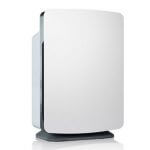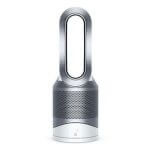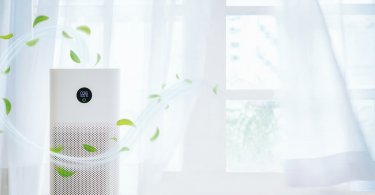
Radon is a highly toxic, naturally occurring gas. It’s mainly found in rocks and soil but can escape into water and air. This is how radon becomes extremely dangerous.
To make things worse, it’s tasteless, odorless, and invisible. Since you can’t detect it, you will never know when you are inhaling radon.
However, taking precautions and safety measures can help you fight this lethal gas. For proper treatment, you must go for radon reduction systems. However, for daily usage, you can consider air purifiers.
These are not only effective for dust, mold, bacteria, allergies, and viruses, but the carbon filters can also help reduce the radon ratio in the air.
Check out the best air purifiers for radon gas down below.
List of the TOP 3 Air Purifiers for Radon Gas
Before we dig in the details of air purifiers that remove radon gas, it’s noteworthy that they may capture some of the radon gas. However, the air purifiers are not as potent as the radon reduction systems. Thus, to be on the safe side, it’s best to discuss it with a radon specialist.
1. Alen BreatheSmart – Best HEPA Air Purifier for Smoke, VOC’s and Chemicals
Designed by NASA airflow engineers, the Alen BreatheSmart is one of the best air purifiers for radon reduction. It can cleanse and purify the air for larger areas. In addition, the air filter absorbs and controls smoke, dust, odors and VOC fumes from aerosol sprays and chemicals.
Available in nine stylish colors, the BreathSmart HEPA air purifier contains a HEPA-FreshPLus filter that includes an activated carbon layer. This activated carbon layer is highly effective in trapping radon and all airborne particles as tiny as 0.3 microns.
You get sensor lights that indicate the air quality of your room. The three colors, blue, orange, and red, depict excellent, medium, and poor air quality.
You can turn on the auto-mode. This mode allows it to take over automatically if there are more particles in the atmosphere. The Alen HEPA air purifier features Advanced WhisperMax technology, which produces a calming pink noise for a sound sleep.
PROS:
- Compact design
- Ideal for bigger spaces
- Air quality sensors
- Advanced WhisperMax technology
- CARB certified
- Lifetime warranty
CONS:
- Relatively noisy
- Glitchy sensors
2. Dyson Air Purifier HP04 – WiFi Enabled, All-in-One Air Purifier
This multi-functional Dyson air purifier is all in one with a purifier, space heater, and fan. It fights against soot, dust, bacteria, and allergens.
The Dyson HP04 comes with an LCD that reports air quality. The automatic sensor senses any level of pollution in the air and auto-initiates the purification process.
It has a stylish, compact design that effectively circulates the internal air and captures 99.97% of allergens through its carbon-activated, HEPA filter. Although small in size, the Dyson claims up to 350 degrees of oscillation.
Furthermore, you get an HP04 purifying space heater for personal heating with a thermostat to control it. The air purifier connects with Wi-Fi and provides you readings on the air quality immediately.
Its Alexa enabled feature gives you the authority to control it with voice commands. The purifier gives promising results to people with acute asthma and allergies and is highly effective in trapping radon particles.
PROS:
- Stylish and compact design
- Wi-Fi connectivity
- Alexa enabled
- All-in-one heater, purifier, and fan
CONS:
- Relatively less airflow
- Sometimes produces clicking or whining noise
3. IQAir GC MultiGas Air Purifier for Radon – Medical Grade Purifier with HyperHEPA Filter
IQAir MultiGas air purifier comes with a hyper HEPA filter and rates as the number one room air purifier for MCS (multiple chemical sensitivity) and smoke. This medical-grade air filtration system professes to be 100% more powerful than regular HEPA filters.
Featuring a MultiGas filtration system, the GC air purifier comes with four disposable filter cartridges. Each carries three pounds of activated carbons, making a total of 12 lbs.
Its cylindrical design supports more connection between the filtration system and the air, resulting in more efficiency.
IQAir purifier is highly effective in trapping radon gas particles and dust, mold, bacteria, and viruses. It includes a remote control, long cord, and castors, making it easy to move around. The design is compact and is available in gray and blue colors.
Moreover, it has a filter-life monitoring system, which tells when you need to change the filter through color-coded light signals.
PROS:
- Traps as small as 0.003 microns
- Exceptionally powerful
- Reduces radon effectively
CONS:
- Relatively noisy
- Release sweet or chemical-ly smell
Must read: Best Home & Industrial Air Scrubbers
Common Questions People Have about Air Purifiers for Radon Gas
What Is Radon?
Radon is an odorless, colorless, and tasteless radioactive gas. Experts can condense radon to a transparent liquid and an opaque, glowing solid as well.
The decay of radioactive elements results in radon formation. Elements like Radium, Uranium, and Thorium in the earth’s crust break down, which results in the radioactive gas release. The gas makes its way to the top surface.
Radon mixes with the underground water, soil and rocks, and makes its way to your house through minuscule cracks. It may mix up in the underground pipelines and reach your home through openings in your basements.
How Dangerous Is Radon?
Radon is highly toxic and dangerous gas. It is the number one cause of lung cancer for non-smokers. When radon escapes the earth’s crust, it may infiltrate your house through the soil, minute cracks or openings in your basement or floor and underground water reservoirs.
This gas is sneaky. You can’t detect it unless tested. It attaches itself to particles in the air and water in your room’s environment. While breathing, these particles may enter through the nose and mouth, ultimately reaching the lungs.
Radon is not only a cause of lung cancer, but it also may cause other types of diseases such as leukemia.
How to Test for Radon Gas in Your Home?
There are three ways to test for radon gas in your home:
- Radon specialist: call a radon expert or professional tester to measure radon levels.
- Quick radon detection test: you can invest in a costlier solution at around $250. It is a device called the Wave radon detector. You can sync it up with your smartphone. The device claims to deliver correct radon levels within an hour of installment.
- In-depth radon detection test: install or place a small device called alpha-track detector, in your basement, where radon gathers. You can then send the device for testing in the lab after about three months.
Radon levels can be higher in the winter season or may fluctuate under different weather patterns.
Does Opening Windows Reduce Radon?
Yes, opening windows does reduce radon as there are more ventilation and better air circulation in the environment. Make sure to open all windows, including those in the basement.
Radon in the house escapes and mixes in the atmosphere. At the same time, the radon-free air from outside mixes up with the internal atmosphere.
Do Air Purifiers Help With Radon Gas?
Yes, air purifiers help with radon gas reduction to some extent.
The air purifiers with activated carbon filter technology are highly effective in trapping radon gas. As mentioned earlier, radon tends to attach itself to numerous airborne and water particles.
Air purifiers attract and trap all the particles in the air on the activated carbon bed.
Is Radon Mitigation Necessary in Your Home?
Yes, this process is necessary for your house. Radon levels change in different seasons and weather conditions, so there is a strong chance when you tested, it came under the EPA approved standard. But it can rise to a dangerous level if left unchecked.
Radon mitigation keeps its level in check and maintained at a lower standard, thus ensuring your family’s safety from direct and excessive exposure.
Wrap Up
Without any doubt, radon is a dangerous gas and can cause lung cancer. Investing in a good air purifier for radon reduction is highly recommended. All the filtration systems mentioned above offer promising results.
However, we would recommend you to weigh your requirements and invest accordingly. In the case of high radon levels, it’s better to seek professional help.










